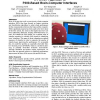60 search results - page 9 / 12 » Rehabilitation with Brain-Computer Interface Systems |
AIIA
2007
Springer
14 years 1 months ago
2007
Springer
A 3D virtual model of the human lower extremity has been developed for the purpose of examining how the neuromuscular system controls the muscles and generates the desired movement...
CA
1999
IEEE
13 years 11 months ago
1999
IEEE
The recent addition of force and touch feedback to Virtual Reality simulations has enhanced their realism. Research on haptics interfaces is now extended to physical modeling of c...
IUI
2010
ACM
14 years 4 months ago
2010
ACM
Most of the previous work on non-invasive brain-computer interfaces (BCIs) has been focused on feature extraction and classification algorithms to achieve high performance for the...
EUSFLAT
2007
13 years 9 months ago
2007
EEG-based brain computer interface (BCI) provides a new communication channel between the human brain and a computer. The classification of EEG data is an important task in EEG-ba...
CHI
2010
ACM
14 years 23 days ago
2010
ACM
The human brain and body are prolific signal generators. Recent technologies and computing techniques allow us to measure, process and interpret these signals. We can now infer su...



